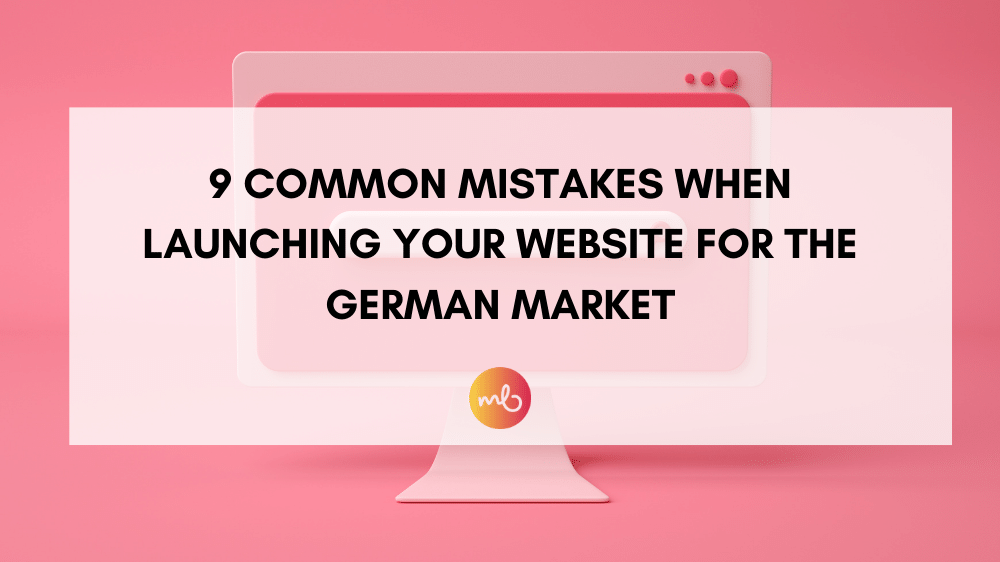
9 Common Mistakes When Launching Your Website for the German Market
You’re ready to take the plunge. You’ve decided to expand your business and enter the German market. You’ve researched your new German audience. You’ve taken a razor-sharp look at your German competitors.
Now all that’s missing is launching a German version of your website so your German customers can actually start buying from you.
But watch out, there are a few pitfalls to avoid here.
In this article, I’ve listed nine common mistakes people make when launching a German website – specifically for non-German business owners.
Keeping them in mind will make your launch onto the German market extra smooth and successful.
So, let’s dive right in.
Mistake #1: Machine translate your website
I know it’s very tempting to use machine translation tools like Google Translate for your website. They‘re free to use and extremely convenient.
However, using these tools might actually drive your German customers away, instead of attracting them. They can easily make your copy and content sound weird and funny and can cause misunderstandings and frustration for your visitors.
Which doesn’t exactly help you stand out from the crowd and generate trust in your brand.
This common mistake can easily be avoided by simply hiring a German human translator. Yes, it will cost money, but it’s an investment well worth making!
Mistake #2: Translating everything on your website
Another common mistake when launching a German website is making an exact German copy of your original English website content. Don’t obsess with getting every little piece of copy and content transferred into German.
Think strategically and be pragmatic about this: What parts of your website are really relevant for your German website visitors? Probably the products and services you’re offering, your About page, T&Cs and things like that.
However, text that’s highly tailored to your domestic visitors might well be irrelevant to your German visitors.
Let me give you an example: I once received a couple of blog posts to translate from English into German for an online travel agency. One of the blog posts was about visiting German Christmas markets.
It didn’t make much sense to translate this for Germans, because they obviously know what that is and don’t need an explanatory blog post about it.
In the same way, information about an event in the UK might not be relevant for your German website visitors – so simply leave it out on the German version of your website.
Mistake #3: Not adapting the time zone, currency and date format on your German website
Have a big sale coming up you want to promote on your English and German websites?
Remember that Germans use different units, have a different currency and sometimes date format, and live in a different time zone to your English-speaking customers.
So, when your special offer ends at a given time on a given date, be super sure to adjust this data to your German customers on your German website.
For example, when your offer ends at midnight UK time, it’s already 1 am in Germany. Also make sure to make your offer in Euros, not Pounds or Dollars.
This mistake is something you actually don’t need to worry too much about when you’re working with a human translator – they will automatically keep an eye on this.
Nonetheless, it’s well worth knowing these things yourself so you don’t make mistakes in your German website copy without realizing it.
Mistake # 4: Not answering questions specific to your German website visitors
You probably have a section on your website that answers the questions your website visitors and customers most frequently have.
Now, your domestic customers probably have different questions to your German ones. This might be purely due to the different locations of both target groups, but is also due to different expectations based on their different cultural backgrounds.
So, instead of simply translating your FAQ page from English into German, tailor that German FAQ page to your German customers.
Make sure to listen closely to your first German customers as you start selling your products to Germany. Ask them how their shopping experience was, what they expected and whether that expectation was fulfilled.
Ask them whether there was any information they would have loved to have in advance. Incorporate these questions and your answers into your German FAQ page for future German customers.
Mistake #5: Not providing reassuring elements on your German website
If you did a little research on your German customers, you might have noticed that Germans can be a little obsessed with safety – especially in the online world.
If you ignore this characteristic of your German customers, selling to them will be a lot harder than necessary.
So again, instead of blindly applying the strategy of your English website to your German website, take a very close look at your German customer’s needs and try to meet them as best as you can.
When it comes to the need for safety, you could for example promote your GDPR-compliance across your German website. Or you could prominently place marks or badges that instill trust on your German website to signal to them that buying on your website is safe.
Don’t neglect these simple and easy to use tools to gain extra trust and make that purchasing decision for your German website visitors a no-brainer.
Mistake #6: Not providing the payment method that Germans prefer for online purchases
Have you considered adapting your available payment methods to your German customers? If not, I strongly advise you do.
According to data by Statista, 80% of German customers have already cancelled a purchase in an online store because their preferred payment method wasn’t available. That’s a huge number of potential sales you will miss out on, simply because you don’t offer a payment method.
So do your research and find out how your German target audience likes to pay. Put that option on your website – and get ready to make sales.
Mistake #7: Make it difficult to find the language option on your website
Another common mistake that global brands make when launching their website in multiple languages is this: They place their language option somewhere in the footer of their website. As if it was some marginal feature. Well, let me tell you: it’s not.
As soon as your potential German customers land on your website (good job!), they need to see how to switch it into their language.
Don’t make them waste time looking for buttons before they can actually browse your site in a language they understand. They will get frustrated and impatient within a matter of seconds, leave your page and look elsewhere.
That’s why savvy global brands place the language option right in the top left or right-hand corner of their websites.
Usually in the shape of a globe symbol, or even more specifically, by simply writing out the available languages (and in that language of the specific target group, so for your German website visitors this would be “Deutsch”).
This again, is a very small change that any small business can easily implement. And at the same time, it’s one that can have a very big impact on the success of your German website.
Mistake #8: Not considering cultural references
This next mistake might be rather tricky to detect for most business owners – which is also why it’s very common.
It’s about the elements of your own culture you unknowingly weave into your German website.
What does that mean?
Take a close look at all your website visuals, for example. Is there anything on there that you usually wouldn’t find in the same setting in Germany? A Thanksgiving dinner table? Driving on the left? Kids in school uniforms?
Also, do your customer reviews reference anything typical of their region? Are your Australian customers rambling about their new boots that are perfect for the mild temperatures there? Then they’re probably not as practical for a German winter.
These things can be very subtle, and they don’t always need to be replaced. It very much depends on your specific situation, what your message is and what you sell to whom.
Don’t worry about this too much, though. If you’re working with a native German translator, they will spot these cultural discrepancies in a blink of an eye and point you in the right direction.
Mistake #9: Perfectionism
Last but not least: Don’t try to make everything perfect.
You probably won’t know it all when you’re starting to expand your business to the German market. That’s ok. It’s normal.
Take your time to learn as you grow your business.
Trying to plan every little detail and being perfectly prepared will most certainly hold you back. It might mean you wait to actually put your products or services on the German market forever. Why make your German customers wait?
You need to be willing to test things out to see if they work.
As soon as you get a feeling for your German audience and customers, things will automatically get easier and come naturally.
Summary
The most common mistakes people make when putting a German website together are easier to avoid than you might think!
As long as you accept that you’re probably not going to get everything totally right straight away and are open to learning about how to nail your communication with a different culture, then you’ll be building a German fan base in no time at all.
So, what are you waiting for?

